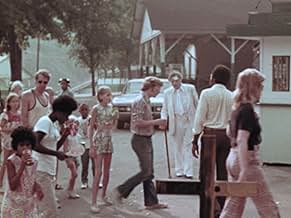The Amusement Park
- 1975
- 53m
IMDb RATING
6.3/10
3.6K
YOUR RATING
An elderly gentleman goes for what he assumes will be an ordinary day at the amusement park, only to find himself in the middle of a hellish nightmare.An elderly gentleman goes for what he assumes will be an ordinary day at the amusement park, only to find himself in the middle of a hellish nightmare.An elderly gentleman goes for what he assumes will be an ordinary day at the amusement park, only to find himself in the middle of a hellish nightmare.
- Director
- Writer
- All cast & crew
- Production, box office & more at IMDbPro
Featured reviews
The topic of elderly people being mistreated in Western society is a perfectly noble one to cover in film. That doesn't exempt filmmakers from providing a story though, or character development of any kind. There's essentially zero of either in The Amusement Park, a "lost film" from the late George Romero that I'd wager is getting praised by critics because of context more than anything.
There isn't much of a film here. Our main character orates to the camera for a few minutes at the beginning, explaining just how poorly seniors are treated. Then for the next 45 odd minutes, seniors are treated poorly at an amusement park. The film plays like a not-particularly-good colourized episode of the Twilight Zone, or perhaps more accurately The Ray Bradbury Theatre.
Was excited for this based on the hype, but sadly it proved little more than a mildly curious historical novelty. Heck of a poster though.
There isn't much of a film here. Our main character orates to the camera for a few minutes at the beginning, explaining just how poorly seniors are treated. Then for the next 45 odd minutes, seniors are treated poorly at an amusement park. The film plays like a not-particularly-good colourized episode of the Twilight Zone, or perhaps more accurately The Ray Bradbury Theatre.
Was excited for this based on the hype, but sadly it proved little more than a mildly curious historical novelty. Heck of a poster though.
A good two years after his passing, relatives of the great George A. Romero discovered and professionally restored a (short) movie the master himself directed in 1973 already. Evidently that, for many diehard horror fanatics - myself included - "The Amusement Park" promptly became one of the must-see genre events of the decade! Seriously, how could this go wrong? Especially with an awesome film poster like that, and the knowledge Romero helmed this little project during his most genius period as a director (namely in between the "Night" and "Dawn"), this was going to be a guaranteed winner!
"The Amusement Park" was apparently never meant to be an actual film, but more like an educational/awareness video message to make clear to younger generations that we are mistreating our senior citizens, and to urge everyone to treat the elderly with a little more respect and dignity. It's somewhat of an extended Public Service Announcement; - if you will! Of course, in the hands of the natural born rebel and anti-conservative George A. Romero, the concept immediately became a grim, shocking, and pitch-black social satire the producers never even dared to unleash upon the world. What a bizarre idea to hire Romero for a PSA-video, anyway. That's like asking Rob Zombie to direct a commercial for diapers, or recruiting Michael Moore to shoot a presidential election promo-video for the Republicans.
Romero's interpretation of the sadly factual and relevant social theme is nothing short of amazing, though. The film, which starts and ends with long speeches by lead actor Lincoln Maazel who elaborates on the subject, is overall extremely powerful, impactful, and very VERY depressing. Fancily dressed and in a joyful mood, our elderly protagonist hopes to have a fun day in a crowded amusement park. He quickly experiences, however, how he and other people of his age are constantly ripped off, patronized, humiliated, ignored, abused, and even physically hurt by all the so-called active and more productive members of society. Various metaphorical sequences are incredibly confronting and harrowing, like how the bumper carts turn into a recognizable traffic situation, or how elderly people are often denied to spent time around (grand-)children. It's a crude but eye-opening film, and it honestly doesn't even matter that it remained shelved for 45 years, because it is still more or less applicable today. Life-expectancy has gone up significantly, but for issue like loneliness and digital analphabetism are the new challenges.
"The Amusement Park" was apparently never meant to be an actual film, but more like an educational/awareness video message to make clear to younger generations that we are mistreating our senior citizens, and to urge everyone to treat the elderly with a little more respect and dignity. It's somewhat of an extended Public Service Announcement; - if you will! Of course, in the hands of the natural born rebel and anti-conservative George A. Romero, the concept immediately became a grim, shocking, and pitch-black social satire the producers never even dared to unleash upon the world. What a bizarre idea to hire Romero for a PSA-video, anyway. That's like asking Rob Zombie to direct a commercial for diapers, or recruiting Michael Moore to shoot a presidential election promo-video for the Republicans.
Romero's interpretation of the sadly factual and relevant social theme is nothing short of amazing, though. The film, which starts and ends with long speeches by lead actor Lincoln Maazel who elaborates on the subject, is overall extremely powerful, impactful, and very VERY depressing. Fancily dressed and in a joyful mood, our elderly protagonist hopes to have a fun day in a crowded amusement park. He quickly experiences, however, how he and other people of his age are constantly ripped off, patronized, humiliated, ignored, abused, and even physically hurt by all the so-called active and more productive members of society. Various metaphorical sequences are incredibly confronting and harrowing, like how the bumper carts turn into a recognizable traffic situation, or how elderly people are often denied to spent time around (grand-)children. It's a crude but eye-opening film, and it honestly doesn't even matter that it remained shelved for 45 years, because it is still more or less applicable today. Life-expectancy has gone up significantly, but for issue like loneliness and digital analphabetism are the new challenges.
THE AMUSEMENT PARK (1975/2019) Shot in 1973 and shelved after a couple of showings in 1975, this George Romero public service film about elder abuse has been rediscovered and remastered.
In many ways, this is a pretty remarkable document. It's a one hour semi-surrealist nightmare about an elderly man (Lincoln Manzel, who also does the introduction) who goes to an Amusement Park. There, he experiences the nightmare rides of his life: Driving, health care, indifferent and even hostile youth, poverty and just general neglect. Not having to adhere to a set 'plot', frees Romero to create some of his most striking scenarios. One bit about the man being shooed away while he's eating crackers and peanut butter and then having rats descend upon his food is as horrifying as anything in his Living Dead pictures. Romero understood that 'reality' is as frightening as anything one could conjure. It's clear why the film was just too odd, too real, for its intended purpose of being a PSA (it was financed by the Lutheran Service Society).
It's not perfect, but THE AMUSEMENT PARK is a glimpse at what Romero could have achieved if he hadn't been pigeonholed. He often played with other styles when making his commercials and industrial films (a Calgon commercial done as a parody of FANTASTIC VOYAGE etc.). This film was shot just before THE CRAZIES and one will notice several of Romero's past and future collaborators in the credits such as Richard R. Rubenstein, the Hinzmans and Michael Gornick. It's a fascinating film that is worthy of reappraisal.
Trivia: Manzel (who was also ion Romero's MARTIN) was 70 when he shot the film. He lived another 36 years! The location, West View Park in Pennsylvania, closed just four years after this movie was made.
In many ways, this is a pretty remarkable document. It's a one hour semi-surrealist nightmare about an elderly man (Lincoln Manzel, who also does the introduction) who goes to an Amusement Park. There, he experiences the nightmare rides of his life: Driving, health care, indifferent and even hostile youth, poverty and just general neglect. Not having to adhere to a set 'plot', frees Romero to create some of his most striking scenarios. One bit about the man being shooed away while he's eating crackers and peanut butter and then having rats descend upon his food is as horrifying as anything in his Living Dead pictures. Romero understood that 'reality' is as frightening as anything one could conjure. It's clear why the film was just too odd, too real, for its intended purpose of being a PSA (it was financed by the Lutheran Service Society).
It's not perfect, but THE AMUSEMENT PARK is a glimpse at what Romero could have achieved if he hadn't been pigeonholed. He often played with other styles when making his commercials and industrial films (a Calgon commercial done as a parody of FANTASTIC VOYAGE etc.). This film was shot just before THE CRAZIES and one will notice several of Romero's past and future collaborators in the credits such as Richard R. Rubenstein, the Hinzmans and Michael Gornick. It's a fascinating film that is worthy of reappraisal.
Trivia: Manzel (who was also ion Romero's MARTIN) was 70 when he shot the film. He lived another 36 years! The location, West View Park in Pennsylvania, closed just four years after this movie was made.
When I first heard George Romero had squirreled away this movie where it couldn't be viewed my first thought was that it was probably awful. In hindsight, this was an understatement.
The Amusement Park comes across as an extended student film that tries to be clever but winds up being both predictable and dull. It doesn't help that the film's introduction basically tells you what you're about to see, making the viewing experience somewhat redundant, and the overblown in-your-face visuals combined with the non-stop cacophonous screaming on the soundtrack makes the 53 minute running time seem like a day and a half.
The "restoration" clearly ran out of money at some point as constant scratches and wildly uneven color balancing totally destroy any concentration the viewer might attempt - not that there's anything to really concentrate on. The bottom line is that it's a bombastic assault of both image and sound that's somehow supposed to indicate that society's elderly are getting a raw deal. And it fails spectacularly in attempting to communicate this sensitive theme.
It makes for nice marketing to imply that the film's financiers found the finished work to be too unsettling, gruesome, horrifying (all of which were used in the ballyhoo trumpeting this film's release,) but in truth it's just not a very good movie and really should've been kept hidden indefinitely.
But, since George's name has a dollar value attached to it and he's no longer a meal ticket to certain people, it's not surprising that this "discovery" was plucked from its dark closet, hurriedly patched together (by the talented colorist of such complex works as Pawn Stars, no less,) and auctioned off to the highest bidder as a "lost" Romero classic.
But the fanboys will still throw money at it because it's "George A. Romero" and they couldn't care less about being bilked as long as their obsession is fed.
The things greedy people do to make money . . it gets no more shameful than this.
The Amusement Park comes across as an extended student film that tries to be clever but winds up being both predictable and dull. It doesn't help that the film's introduction basically tells you what you're about to see, making the viewing experience somewhat redundant, and the overblown in-your-face visuals combined with the non-stop cacophonous screaming on the soundtrack makes the 53 minute running time seem like a day and a half.
The "restoration" clearly ran out of money at some point as constant scratches and wildly uneven color balancing totally destroy any concentration the viewer might attempt - not that there's anything to really concentrate on. The bottom line is that it's a bombastic assault of both image and sound that's somehow supposed to indicate that society's elderly are getting a raw deal. And it fails spectacularly in attempting to communicate this sensitive theme.
It makes for nice marketing to imply that the film's financiers found the finished work to be too unsettling, gruesome, horrifying (all of which were used in the ballyhoo trumpeting this film's release,) but in truth it's just not a very good movie and really should've been kept hidden indefinitely.
But, since George's name has a dollar value attached to it and he's no longer a meal ticket to certain people, it's not surprising that this "discovery" was plucked from its dark closet, hurriedly patched together (by the talented colorist of such complex works as Pawn Stars, no less,) and auctioned off to the highest bidder as a "lost" Romero classic.
But the fanboys will still throw money at it because it's "George A. Romero" and they couldn't care less about being bilked as long as their obsession is fed.
The things greedy people do to make money . . it gets no more shameful than this.
'The Amusement Park (1973)' is basically a PSA regarding elder abuse, bookended by extended fourth-wall breaks that outright tell you its mission statement. It's considered 'lost' because the people who commissioned it were supposedly so horrified by it that they buried it, making sure it never saw the light of day. Recently, it has been unearthed and restored in 4K, making its way over to Shudder as an exclusive piece of content. For seasoned horror fans, the flick is somewhat of an amusing oddity. It may very well be worth watching just to see what a Romero-made PSA actually looks like. However, it probably won't hit home for most audiences, despite its good intentions and general technical prowess, because it simply isn't all that engaging. Its eponymous amusement park is allegorical for life, being fun for its younger visitors but not so much fun for its older ones. Instead of height restrictions, rides are restricted by health, wage and general social status. The bumper cars require valid licences, the snack stands give out paper grocery bags, the 'freak shows' consist of only OAPs. The picture essentially puts you in the position of an innocent and eager older gentleman who gets consistently beaten down by the park's unfair systems. It's a fairly claustrophobic watch that has a relatively strong sense of escalation to it. However, even though it should work well, it ultimately falls a little flat. As I said earlier, it isn't all that engaging. In fact, it's actually quite dull. It also isn't as scary as some people are making it out to be; it's barely a horror film, if I'm honest (not that that's really an issue). I wish I liked this more than I do. 4/10.
Did you know
- TriviaAn organization called the Lutheran Society hired George A. Romero to create a movie about elder abuse and the importance of showing respect to older people. When Romero presented the society with his surreal and frightening take on the subject, they were so shocked and horrified by what they saw that they hid the film and never showed it to anyone. It would be 45 years before the film would be seen again.
- GoofsThe sign for requirements to go on a ride says riders can't have "hardning of arteries" instead of "hardening of arteries".
- ConnectionsFeatured in Half in the Bag: 2021 Movie Catch-Up (part 1 of 2) (2022)
Details
- Release date
- Country of origin
- Official site
- Language
- Also known as
- El parque de diversiones
- Filming locations
- West View, Pennsylvania, USA(West View Park)
- Production companies
- See more company credits at IMDbPro
Box office
- Budget
- $37,000 (estimated)
Contribute to this page
Suggest an edit or add missing content






















